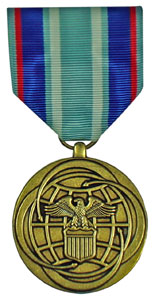Air and Space Campaign Medal

The Air and Space Campaign Medal ( ASCM ) is a military decoration of the United States Air Force which was first created on April 24, 2002 by order of Secretary of the Air Force James G. Roche . The ASCM may be awarded to members of the USAF who, after March 24, 1999, supported a significant U.S. military operation designated by the Chief of Staff of the United States Air Force as qualifying for the ASCM.
To be eligible for the Air and Space Campaign Medal a service member must perform direct support of a military operation for at least thirty consecutive days or for sixty non-consecutive days. "Direct support" is defined as deploying in support of an ASCM approved operation or if performing functions at home station or from outside the geographic area of combat which historically were deployed forward, or entirely new and future missions., which due to technological advances are no longer constrained by geographic location. This includes, but is not limited to, sortie generation, intelligence, surveillance, targeting, computer network attack operations, etc. Squadron Commanders may determine other functions that meet the intent of this award.
Members who provided direct support for 30 consecutive or 60 nonconsecutive days to one of these operations, at homestation, or from outside of the geographic area of combat qualify for the ASCM.
Air and Space Campaign Medal takes precedence immediately after the Military Outstanding Volunteer Service Medal .
The Air and Space Campaign Medal is only authorized to Air Force personnel and is prohibited for issuance if another campaign or service medal has already been received for the operation in question. Additional decorations are denoted by service stars .
Military operations that qualify
- Operation Allied Force (24 March – 10 June 1999)
- Operation Joint Guardian (11 June 1999 – Date to Be Determined (DTBD))
- Operation Allied Harbour (4 April – 1 September 1999)
- Operation Sustain Hope / Operation Shining Hope (4 April – 10 July 1999)
- Operation Noble Anvil (24 March – 20 July 1999)
- Kosovo Task Forces HAWK (5 April – 24 June 1999)
- Operation Saber (31 March – 8 July 1999)
- Operation Falcon (11 June 1999 – DTBD)
- Operation Hunter (1 April – 1 November 1999)